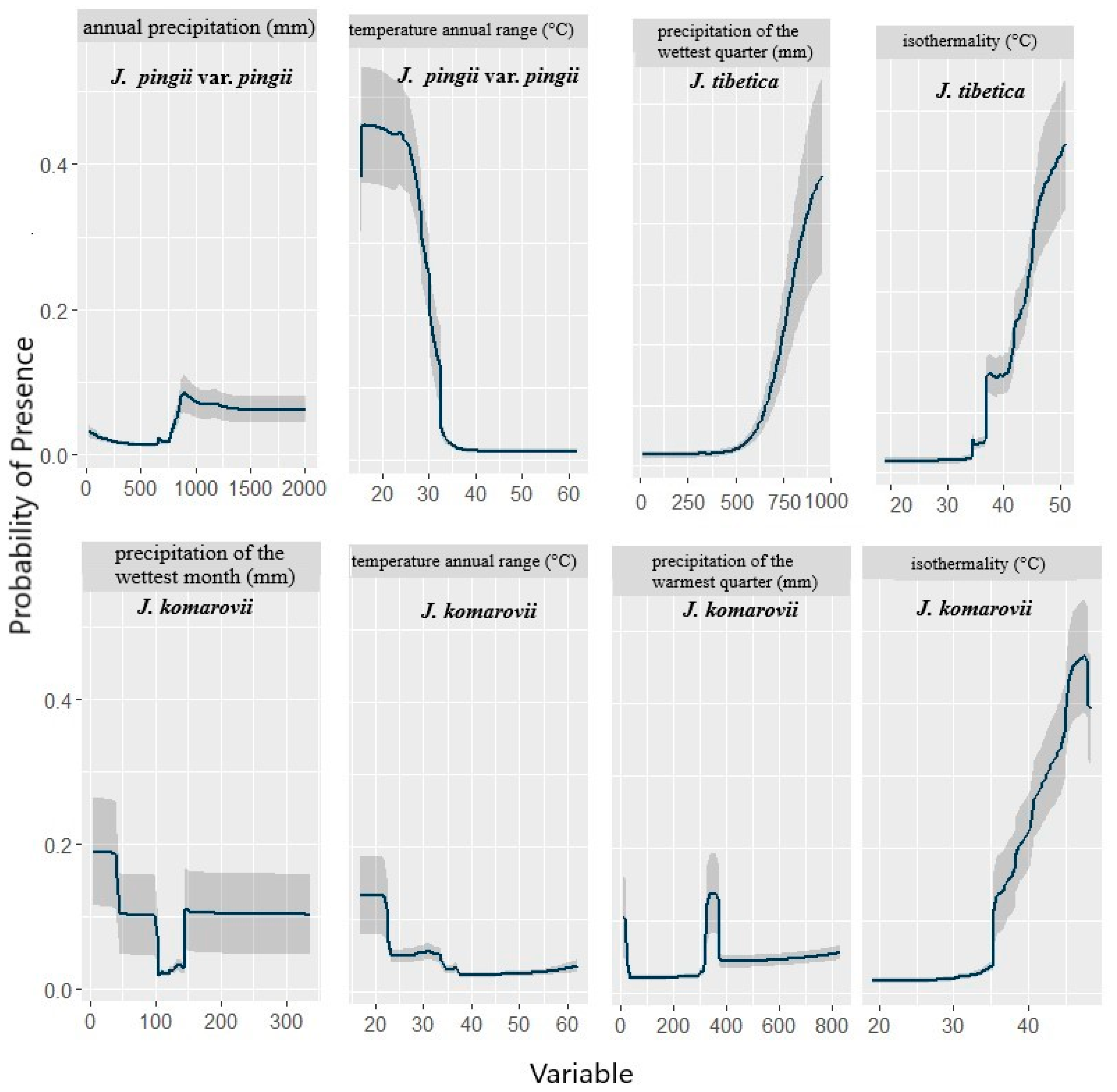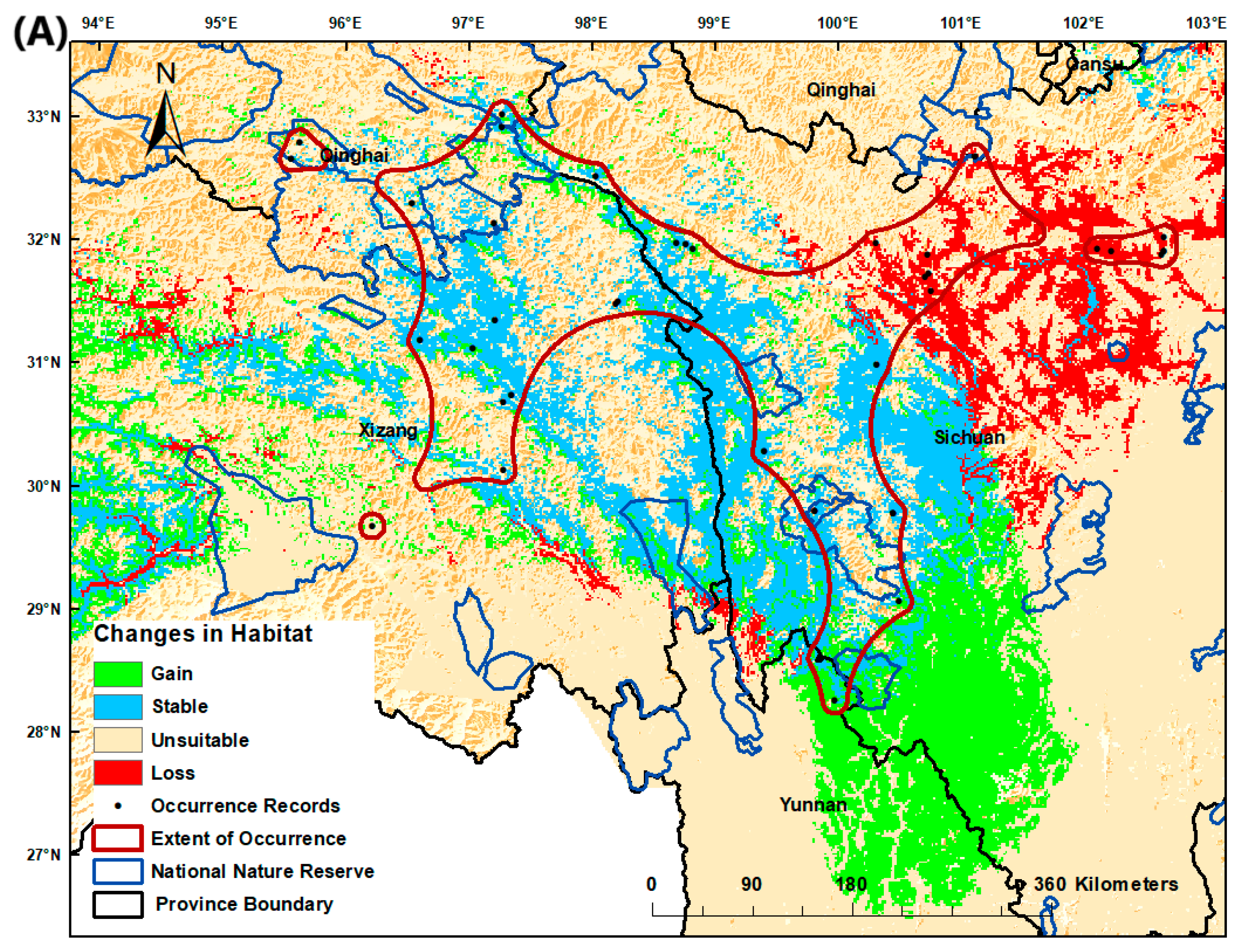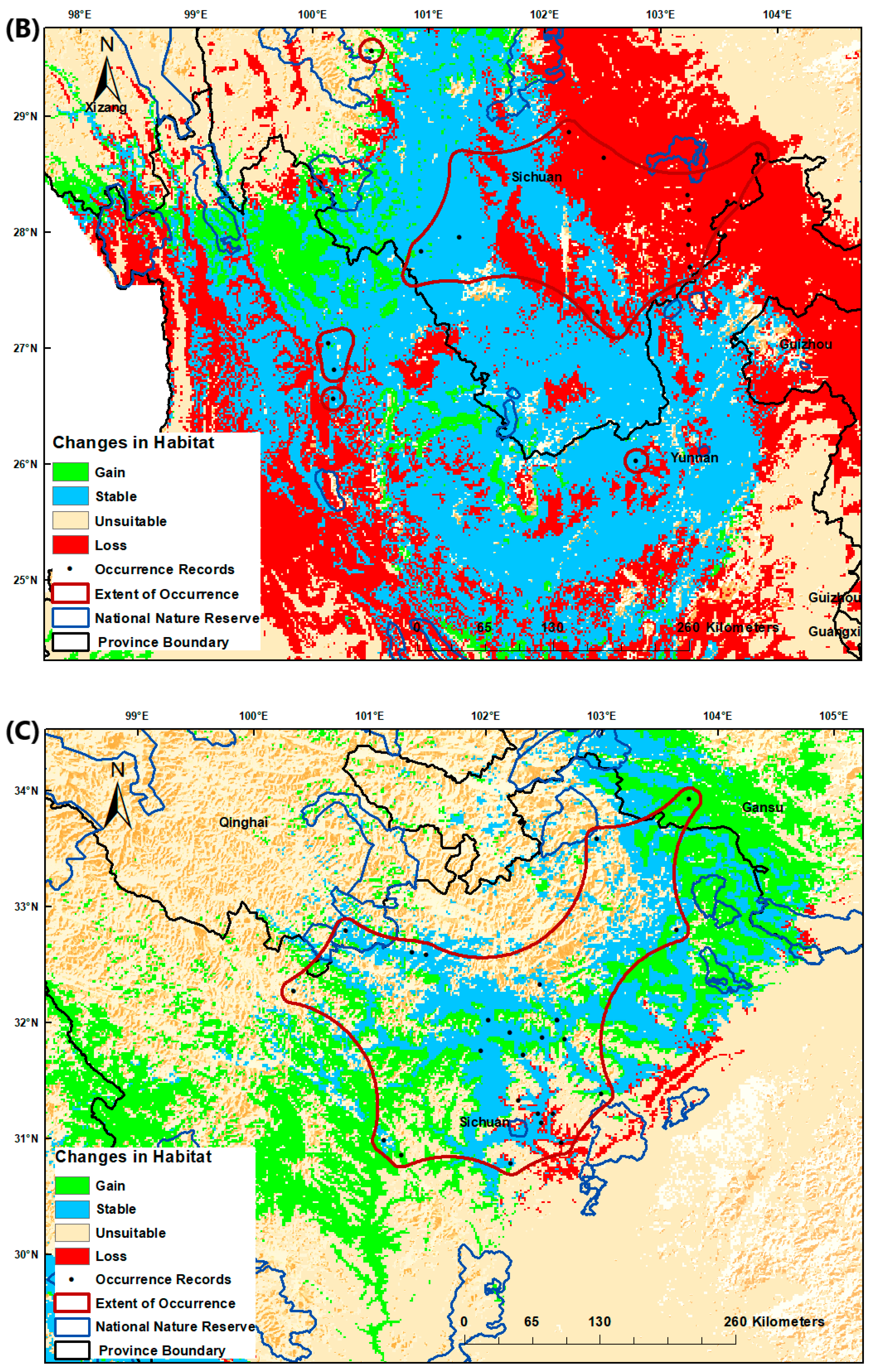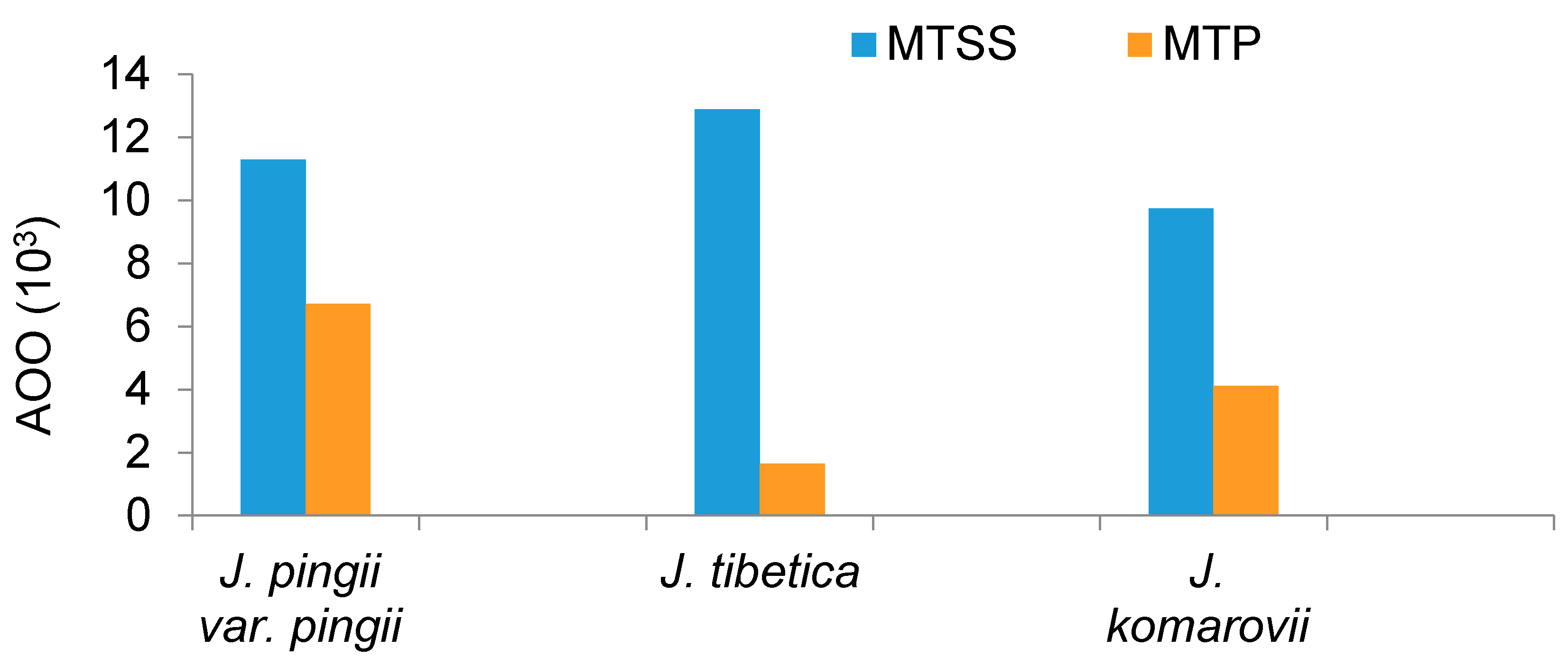Endemic Juniperus Montane Species Facing Extinction Risk under Climate Change in Southwest China: Integrative Approach for Conservation Assessment and Prioritization
Abstract
Simple Summary
Abstract
1. Introduction
2. Materials and Methods
2.1. Species Occurrence Data and Conservation Status
2.2. Environmental Variables and Multicollinearity
2.3. Models Construction and Ensemble Modelling
2.4. AOO Estimation and Extinction Risk Assessment
3. Results
3.1. Model Performance and Response to Climatic Changes
3.2. Potential Suitability and Projected AOO under Climate and Dispersal Scenarios
3.3. Potential Changes in Extinction Risk under Climate Scenarios
4. Discussion
4.1. Distribution Modelling and Conservation Assessment
4.2. Impact of Climate Change on the Habitat Suitability and Projected AOO
4.3. Risk of Extinction under Climate and Dispersal Scenarios
4.4. Conservation Implications
5. Conclusions
Supplementary Materials
Author Contributions
Funding
Data Availability Statement
Conflicts of Interest
References
- Pacifici, M.; Foden, W.B.; Visconti, P.; Watson, J.E.M.; Butchart, S.H.M.; Kovacs, K.M.; Scheffers, B.R.; Hole, D.G.; Martin, T.G.; Akçakaya, H.R. Assessing species vulnerability to climate change. Nat. Clim. Chang. 2015, 5, 215–224. [Google Scholar] [CrossRef]
- He, X.; Burgess, K.S.; Gao, L.M.; Li, D.Z. Distributional responses to climate change for alpine species of Cyananthus and Primula endemic to the Himalaya-Hengduan Mountains. Plant Divers. 2019, 41, 26–32. [Google Scholar] [CrossRef] [PubMed]
- Wiens, J.J. Climate-related local extinctions are already widespread among plant and animal species. PLoS Biol. 2016, 14, e2001104. [Google Scholar] [CrossRef] [PubMed]
- Boogar, A.R.; Salehi, H.; Pourghasemi, H.R.; Blaschke, T. Predicting habitat suitability and conserving Juniperus spp. habitat using SVM and maximum entropy machine learning techniques. Water 2019, 11, 2049. [Google Scholar] [CrossRef]
- Engler, R.; Randin, C.F.; Thuiller, W.; Dullinger, S.; Zimmermann, N.E.; Araújo, M.B.; Pearman, P.B.; Le Lay, G.; Piedallu, C.; Albert, C.H. 21st century climate change threatens mountain flora unequally across Europe. Glob. Chang. Biol. 2011, 17, 2330–2341. [Google Scholar] [CrossRef]
- Casagranda, D.; de Grosso, M.L. Areas of Endemism: Methodological and applied biogeographic contributions from South America. Curr. Prog. Biol. Res. 2013, 24, 1. [Google Scholar]
- Orsenigo, S.; Montagnani, C.; Fenu, G.; Gargano, D.; Peruzzi, L.; Abeli, T.; Alessandrini, A.; Bacchetta, G.; Bartolucci, F.; Bovio, M.; et al. Red Listing plants under full national responsibility: Extinction risk and threats in the vascular flora endemic to Italy. Biol. Conserv. 2018, 224, 213–222. [Google Scholar] [CrossRef]
- Isaac, N.J.B.; Turvey, S.T.; Collen, B.; Waterman, C.; Baillie, J.E.M. Mammals on the EDGE: Conservation priorities based on threat and phylogeny. PLoS ONE 2007, 2, e296. [Google Scholar] [CrossRef]
- Zhang, B.; Yao, Y.; Zhao, C.; Wang, J.; Yu, F. Conifers in Mountains of China. In Conifers; IntechOpen: London, UK, 2018. [Google Scholar]
- Seim, A.; Omurova, G.; Azisov, E.; Musuraliev, K.; Aliev, K.; Tulyaganov, T.; Nikolyai, L.; Botman, E.; Helle, G.; Dorado Liñan, I. Climate change increases drought stress of Juniper trees in the mountains of Central Asia. PLoS ONE 2016, 11, e0153888. [Google Scholar] [CrossRef]
- Thomas, C.D.; Cameron, A.; Green, R.E.; Bakkenes, M.; Beaumont, L.J.; Collingham, Y.C.; Erasmus, B.F.N.; De Siqueira, M.F.; Grainger, A.; Hannah, L. Extinction risk from climate change. Nature 2004, 427, 145–148. [Google Scholar] [CrossRef]
- Abrha, H.; Birhane, E.; Hagos, H.; Manaye, A. Predicting suitable habitats of endangered Juniperus procera tree under climate change in Northern Ethiopia. J. Sustain. For. 2018, 37, 842–853. [Google Scholar] [CrossRef]
- Franklin, J.; Davis, F.W.; Ikegami, M.; Syphard, A.D.; Flint, L.E.; Flint, A.L.; Hannah, L. Modeling plant species distributions under future climates: How fine scale do climate projections need to be? Glob. Chang. Biol. 2013, 19, 473–483. [Google Scholar] [CrossRef] [PubMed]
- Gutierrez, D. Effectiveness of existing reserves in the long-term protection of a regionally rare butterfly. Conserv. Biol. 2005, 19, 1586–1597. [Google Scholar] [CrossRef]
- Fois, M.; Fenu, G.; Lombrana, A.C.; Cogoni, D.; Bacchetta, G. A practical method to speed up the discovery of unknown populations using Species Distribution Models. J. Nat. Conserv. 2015, 24, 42–48. [Google Scholar] [CrossRef]
- Wang, H.-H.; Wonkka, C.L.; Treglia, M.L.; Grant, W.E.; Smeins, F.E.; Rogers, W.E. Incorporating local-scale variables into distribution models enhances predictability for rare plant species with biological dependencies. Biodivers. Conserv. 2019, 28, 171–182. [Google Scholar] [CrossRef]
- Dakhil, M.A.; Xiong, Q.; Farahat, E.A.; Zhang, L.; Pan, K.; Pandey, B.; Olatunji, O.A.; Tariq, A.; Wu, X.; Zhang, A.; et al. Past and future climatic indicators for distribution patterns and conservation planning of temperate coniferous forests in southwestern China. Ecol. Indic. 2019, 107, 105559. [Google Scholar] [CrossRef]
- Cheddadi, R.; Birks, H.J.B.; Tarroso, P.; Liepelt, S.; Gömöry, D.; Dullinger, S.; Meier, E.S.; Hülber, K.; Maiorano, L.; Laborde, H. Revisiting tree-migration rates: Abies alba (Mill.), a case study. Veg. Hist. Archaeobot. 2014, 23, 113–122. [Google Scholar] [CrossRef]
- Holliday, J.A.; Suren, H.; Aitken, S.N. Divergent selection and heterogeneous migration rates across the range of Sitka spruce (Picea sitchensis). Proc. R. Soc. B Biol. Sci. 2012, 279, 1675–1683. [Google Scholar] [CrossRef]
- Shaheen, H.; Awan, S.N.; Aziz, S. Distribution Pattern, Conservation Status, and Associated Flora of the Genus Juniperus in Subalpine Pastures of the Kashmir Himalayas. Mt. Res. Dev. 2017, 37, 487–493. [Google Scholar] [CrossRef]
- Gonny, M.; Cavaleiro, C.; Salgueiro, L.; Casanova, J. Analysis of Juniperus communis subsp. alpina needle, berry, wood and root oils by combination of GC, GC/MS and 13C-NMR. Flavour Fragr. J. 2006, 21, 99–106. [Google Scholar] [CrossRef]
- Rawat, Y.S.; Vishvakarma, S.C.R.; Todaria, N.P. Fuel wood consumption pattern of tribal communities in cold desert of the Lahaul valley, North-Western Himalaya, India. Biomass Bioenergy 2009, 33, 1547–1557. [Google Scholar] [CrossRef]
- Ozkan, K.; Gulsoy, S.; Aerts, R.; Muys, B. Site properties for Crimean juniper (Juniperus excelsa) in semi-natural forests of south western Anatolia, Turkey. J. Environ. Biol. 2010, 31, 97. [Google Scholar] [PubMed]
- Nüsser, M.; Schmidt, S. Nanga Parbat revisited: Evolution and dynamics of sociohydrological interactions in the Northwestern Himalaya. Ann. Am. Assoc. Geogr. 2017, 107, 403–415. [Google Scholar] [CrossRef]
- Li, Z.-H.; Liu, Z.-L.; Wang, Y.-J.; Fang, M.-F.; Wang, M.-L.; Li, Z.-X.; Zhao, G.-F. Isolation and characterization of polymorphic microsatellite loci in Ping’s juniper Juniperus pingii. Conserv. Genet. Resour. 2013, 5, 683–685. [Google Scholar] [CrossRef]
- Opgenoorth, L. Identification and characterization of microsatellite marker in the tetraploid Juniperus tibetica Kom. using next generation sequencing. Conserv. Genet. Resour. 2009, 1, 253. [Google Scholar] [CrossRef]
- Yang, Y.; Liao, W. Juniperus komarovii. The IUCN Red List of Threatened Species 2013: E.T34138A2847556. Available online: https://www.iucnredlist.org/species/34138/2847556 (accessed on 1 May 2020).
- Farjon, A.; Gardner, M.; Thomas, P. Conifer Database (version Jan 2014). In Species 2000 ITIS Catalogue of Life: 2020 Annual C; Roskov, Y., Ower, G., Orrell, T., Nicolson, D., Bailly, N., Kirk, P.M., Bourgoin, T., DeWalt, R.E., Decock, W., van Nieukerken, E., et al., Eds.; Naturalis: Leiden, The Netherlands, 2020. [Google Scholar]
- Farjon, A. Juniperus Tibetica. In IUCN Red List of Threatened Species. Version 2013.1. IUCN 2013. Available online: www.iucnredlist.org (accessed on 6 July 2013).
- IUCN. Guidelines for Using the IUCN Red List Categories and Criteria, Ver. 13. Available online: https://www.iucnredlist.org/resources/redlistguidelines (accessed on 12 December 2020).
- Fick, S.E.; Hijmans, R.J. WorldClim 2: New 1-km spatial resolution climate surfaces for global land areas. Int. J. Climatol. 2017, 37, 4302–4315. [Google Scholar] [CrossRef]
- Wu, T.; Song, L.; Li, W.; Wang, Z.; Zhang, H.; Xin, X.; Zhang, Y.; Zhang, L.; Li, J.; Wu, F. An overview of BCC climate system model development and application for climate change studies. J. Meteorol. Res. 2014, 28, 34–56. [Google Scholar] [CrossRef]
- Ul Hasson, S.; Pascale, S.; Lucarini, V.; Böhner, J. Seasonal cycle of precipitation over major river basins in South and Southeast Asia: A review of the CMIP5 climate models data for present climate and future climate projections. Atmos. Res. 2016, 180, 42–63. [Google Scholar] [CrossRef]
- Wang, L.; Chen, W. A CMIP5 multimodel projection of future temperature, precipitation, and climatological drought in China. Int. J. Climatol. 2014, 34, 2059–2078. [Google Scholar] [CrossRef]
- IPCC. Climate Change 2013: The Physical Science Basis: Working Group I Contribution to the Fifth Assessment Report of the Intergovernmental Panel on Climate Change; Cambridge University Press: Cambridge, UK, 2014; ISBN 110705799X. [Google Scholar]
- Hijmans, R.J.; van Etten, J.; Cheng, J.; Mattiuzzi, M.; Sumner, M.; Greenberg, J.A.; Hijmans, M.R.J. Package ‘Raster’ 2015. Available online: https://cran.r-project.org/web/packages/raster/raster.pdf (accessed on 12 December 2020).
- Naimi, B.; Araújo, M.B. sdm: A reproducible and extensible R platform for species distribution modelling. Ecography 2016, 39, 368–375. [Google Scholar] [CrossRef]
- Naimi, B. usdm: Uncertainty Analysis for Species Distribution Models. R Package Version 1.1–15. R Doc. 2015. Available online: http//www.rdocu-mentation.org/packages/usdm (accessed on 12 December 2020).
- Guisan, A.; Thuiller, W.; Zimmermann, N.E. Habitat Suitability and Distribution Models: With Applications in R; Cambridge University Press: Cambridge, UK, 2017; ISBN 0521765137. [Google Scholar]
- Iturbide, M.; Bedia, J.; Gutiérrez, J.M. Background sampling and transferability of species distribution model ensembles under climate change. Glob. Planet. Chang. 2018, 166, 19–29. [Google Scholar] [CrossRef]
- Ahmed, S.E.; McInerny, G.; O’Hara, K.; Harper, R.; Salido, L.; Emmott, S.; Joppa, L.N. Scientists and software–surveying the species distribution modelling community. Divers. Distrib. 2015, 21, 258–267. [Google Scholar] [CrossRef]
- Norberg, A.; Abrego, N.; Blanchet, F.G.; Adler, F.R.; Anderson, B.J.; Anttila, J.; Araújo, M.B.; Dallas, T.; Dunson, D.; Elith, J. A comprehensive evaluation of predictive performance of 33 species distribution models at species and community levels. Ecol. Monogr. 2019, 89, e01370. [Google Scholar] [CrossRef]
- Thuiller, W.; Guéguen, M.; Renaud, J.; Karger, D.N.; Zimmermann, N.E. Uncertainty in ensembles of global biodiversity scenarios. Nat. Commun. 2019, 10, 1446. [Google Scholar] [CrossRef] [PubMed]
- Zhang, Z.; Mammola, S.; Xian, W.; Zhang, H. Modelling the potential impacts of climate change on the distribution of ichthyoplankton in the Yangtze Estuary, China. Divers. Distrib. 2020, 26, 126–137. [Google Scholar] [CrossRef]
- Barbet-Massin, M.; Jiguet, F.; Albert, C.H.; Thuiller, W. Selecting pseudo-absences for species distribution models: How, where and how many? Methods Ecol. 2012, 3, 327–338. [Google Scholar] [CrossRef]
- Breiner, F.T.; Nobis, M.P.; Bergamini, A.; Guisan, A. Optimizing ensembles of small models for predicting the distribution of species with few occurrences. Methods Ecol. Evol. 2018, 9, 802–808. [Google Scholar] [CrossRef]
- Liu, C.; Newell, G.; White, M. On the selection of thresholds for predicting species occurrence with presence-only data. Ecol. Evol. 2016, 6, 337–348. [Google Scholar] [CrossRef]
- Tuanmu, M.; Jetz, W. A global 1-km consensus land-cover product for biodiversity and ecosystem modelling. Glob. Ecol. Biogeogr. 2014, 23, 1031–1045. [Google Scholar] [CrossRef]
- Keith, D.A.; Akçakaya, H.R.; Murray, N.J. Scaling range sizes to threats for robust predictions of risks to biodiversity. Conserv. Biol. 2018, 32, 322–332. [Google Scholar] [CrossRef]
- Meynard, C.N.; Leroy, B.; Kaplan, D.M. Testing methods in species distribution modelling using virtual species: What have we learnt and what are we missing? Ecography 2019, 42, 2021–2036. [Google Scholar] [CrossRef]
- Dauby, G.; Stévart, T.; Droissart, V.; Cosiaux, A.; Deblauwe, V.; Simo-Droissart, M.; Sosef, M.S.M.; Lowry, P.P.; Schatz, G.E.; Gereau, R.E. ConR: An R package to assist large-scale multispecies preliminary conservation assessments using distribution data. Ecol. Evol. 2017, 7, 11292–11303. [Google Scholar] [CrossRef] [PubMed]
- Syfert, M.M.; Joppa, L.; Smith, M.J.; Coomes, D.A.; Bachman, S.P.; Brummitt, N.A. Using species distribution models to inform IUCN Red List assessments. Biol. Conserv. 2014, 177, 174–184. [Google Scholar] [CrossRef]
- Burgman, M.A.; Fox, J.C. Bias in species range estimates from minimum convex polygons: Implications for conservation and options for improved planning. Anim. Conserv. 2003, 6, 19–28. [Google Scholar] [CrossRef]
- Kaky, E.; Gilbert, F. Assessment of the extinction risks of medicinal plants in Egypt under climate change by integrating species distribution models and IUCN Red List criteria. J. Arid Environ. 2019, 170, 103988. [Google Scholar]
- Qin, A.; Liu, B.; Guo, Q.; Bussmann, R.W.; Ma, F.; Jian, Z.; Xu, G.; Pei, S. Maxent modeling for predicting impacts of climate change on the potential distribution of Thuja sutchuenensis Franch., an extremely endangered conifer from southwestern China. Glob. Ecol. Conserv. 2017, 10, 139–146. [Google Scholar] [CrossRef]
- Ma, B.; Sun, J. Predicting the distribution of Stipa purpurea across the Tibetan Plateau via the MaxEnt model. BMC Ecol. 2018, 18, 10. [Google Scholar] [CrossRef]
- Ren, Z.; Zagortchev, L.; Ma, J.; Yan, M.; Li, J. Predicting the potential distribution of the parasitic Cuscuta chinensis under global warming. BMC Ecol. 2020, 20, 28. [Google Scholar] [CrossRef]
- Lenoir, J.; Gégout, J.-C.; Marquet, P.A.; De Ruffray, P.; Brisse, H. A significant upward shift in plant species optimum elevation during the 20th century. Science 2008, 320, 1768–1771. [Google Scholar] [CrossRef]
- Lenoir, J.; Svenning, J. Climate-related range shifts–a global multidimensional synthesis and new research directions. Ecography 2015, 38, 15–28. [Google Scholar] [CrossRef]
- Royce, E.B. Snowmelt variation contributes to topoclimatic refugia under montane Mediterranean climate change. Can. J. For. Res. 2018, 48, 1526–1534. [Google Scholar] [CrossRef]
- Rumpf, S.B.; Hülber, K.; Klonner, G.; Moser, D.; Schütz, M.; Wessely, J.; Willner, W.; Zimmermann, N.E.; Dullinger, S. Range dynamics of mountain plants decrease with elevation. Proc. Natl. Acad. Sci. USA 2018, 115, 1848–1853. [Google Scholar] [CrossRef] [PubMed]
- Feeley, K.J.; Silman, M.R. Land-use and climate change effects on population size and extinction risk of Andean plants. Glob. Chang. Biol. 2010, 16, 3215–3222. [Google Scholar] [CrossRef]
- La Sorte, F.A.; Jetz, W. Projected range contractions of montane biodiversity under global warming. Proc. R. Soc. B Biol. Sci. 2010, 277, 3401–3410. [Google Scholar] [CrossRef] [PubMed]
- Ponce-Reyes, R.; Nicholson, E.; Baxter, P.W.J.; Fuller, R.A.; Possingham, H. Extinction risk in cloud forest fragments under climate change and habitat loss. Divers. Distrib. 2013, 19, 518–529. [Google Scholar] [CrossRef]
- Tejedor Garavito, N.; Newton, A.C.; Golicher, D.; Oldfield, S. The relative impact of climate change on the extinction risk of tree species in the montane tropical Andes. PLoS ONE 2015, 10, e0131388. [Google Scholar] [CrossRef]
- Elsen, P.R.; Tingley, M.W. Global mountain topography and the fate of montane species under climate change. Nat. Clim. Chang. 2015, 5, 772–776. [Google Scholar] [CrossRef]
- Wu, J. Risk and uncertainty of losing suitable habitat areas under climate change scenarios: A case study for 109 gymnosperm species in China. Environ. Manag. 2020, 65, 517–533. [Google Scholar] [CrossRef]
- Cheddadi, R.; Araújo, M.B.; Maiorano, L.; Edwards, M.; Guisan, A.; Carré, M.; Chevalier, M.; Pearman, P.B. Temperature range shifts for three European tree species over the last 10,000 years. Front. Plant Sci. 2016, 7, 1581. [Google Scholar] [CrossRef]
- Liao, Z.; Zhang, L.; Nobis, M.P.; Wu, X.; Pan, K.; Wang, K.; Dakhil, M.A.; Du, M.; Xiong, Q.; Pandey, B. Climate change jointly with migration ability affect future range shifts of dominant fir species in Southwest China. Divers. Distrib. 2020, 26, 352–367. [Google Scholar] [CrossRef]
- Miehe, G.; Miehe, S.; Vogel, J.; La, D. Highest treeline in the northern hemisphere found in southern Tibet. Mt. Res. Dev. 2007, 27, 169–173. [Google Scholar] [CrossRef]
- Adams, R.P. Junipers of the World: The Genus Juniperus; Trafford Publishing: Bloomington, IN, USA, 2014; ISBN 1490723250. [Google Scholar]
- Fan, Z.-X.; Bräuning, A.; Cao, K.-F.; Zhu, S.-D. Growth–climate responses of high-elevation conifers in the central Hengduan Mountains, southwestern China. For. Ecol. Manag. 2009, 258, 306–313. [Google Scholar] [CrossRef]
- Fang, K.; Gou, X.; Chen, F.; Peng, J.; D’Arrigo, R.; Wright, W.; Li, M.-H. Response of regional treeline forests to climate change: Evidence from the northeastern Tibetan Plateau. Trees 2009, 23, 1321. [Google Scholar] [CrossRef]
- Liang, E.Y.; Shao, X.M.; Xu, Y. Tree-ring evidence of recent abnormal warming on the south-east Tibetan Plateau. Theor. Appl. Climatol. 2009, 98, 9–18. [Google Scholar] [CrossRef]
- He, M.; Yang, B.; Bräuning, A. Tree growth–climate relationships of Juniperus tibetica along an altitudinal gradient on the southern Tibetan Plateau. Trees 2013, 27, 429–439. [Google Scholar] [CrossRef]
- O’Donnell, M.S.; Ignizio, D.A. Bioclimatic predictors for supporting ecological applications in the conterminous United States. US Geol. Surv. Data Ser. 2012, 691, 10. [Google Scholar]
- Wang, W.; Jia, M.; Wang, G.; Zhu, W.; McDowell, N.G. Rapid warming forces contrasting growth trends of subalpine fir (Abies fabri) at higher-and lower-elevations in the eastern Tibetan Plateau. For. Ecol. Manag. 2017, 402, 135–144. [Google Scholar] [CrossRef]
- Chhetri, P.K.; Gaddis, K.D.; Cairns, D.M. Predicting the suitable habitat of treeline species in the Nepalese Himalayas under climate change. Mt. Res. Dev. 2018, 38, 153–163. [Google Scholar] [CrossRef]
- Liu, R.; Wang, C.-J.; He, J.; Zhang, Z. Analysis of geographical distribution of Abies in China under climate change. Bull. Bot. Res. 2018, 38, 37–46. [Google Scholar]
- Bräuning, A.; Grießinger, J.; Hochreuther, P.; Wernicke, J. Dendroecological perspectives on climate change on the southern Tibetan plateau. In Climate Change, Glacier Response, and Vegetation Dynamics in the Himalaya; Springer: Cham, Switzerland, 2016; pp. 347–364. [Google Scholar]
- Taylor, P.J.; Ogony, L.; Ogola, J.; Baxter, R.M. South African mouse shrews (Myosorex) feel the heat: Using species distribution models (SDMs) and IUCN Red List criteria to flag extinction risks due to climate change. Mammal Res. 2017, 62, 149–162. [Google Scholar] [CrossRef]
- Guo, F.; Lenoir, J.; Bonebrake, T.C. Land-use change interacts with climate to determine elevational species redistribution. Nat. Commun. 2018, 9, 1315. [Google Scholar] [CrossRef] [PubMed]
- Årevall, J.; Early, R.; Estrada, A.; Wennergren, U.; Eklöf, A.C. Conditions for successful range shifts under climate change: The role of species dispersal and landscape configuration. Divers. Distrib. 2018, 24, 1598–1611. [Google Scholar] [CrossRef]
- Tischendorf, L.; Fahrig, L. On the usage and measurement of landscape connectivity. Oikos 2000, 90, 7–19. [Google Scholar] [CrossRef]
- Clark, R.W.; Marchand, M.N.; Clifford, B.J.; Stechert, R.; Stephens, S. Decline of an isolated timber rattlesnake (Crotalus horridus) population: Interactions between climate change, disease, and loss of genetic diversity. Biol. Conserv. 2011, 144, 886–891. [Google Scholar] [CrossRef]
- Peterson, A.T.; Soberón, J.; Pearson, R.G.; Anderson, R.P.; Martínez-Meyer, E.; Nakamura, M.; Araújo, M.B. Ecological Niches and Geographic Distributions (MPB-49); Princeton University Press: Princeton, NJ, USA, 2011; Volume 49, ISBN 1400840678. [Google Scholar]
- Ramirez-Reyes, C.; Bateman, B.L.; Radeloff, V.C. Effects of habitat suitability and minimum patch size thresholds on the assessment of landscape connectivity for jaguars in the Sierra Gorda, Mexico. Biol. Conserv. 2016, 204, 296–305. [Google Scholar] [CrossRef]
- Santini, L.; Benítez-López, A.; Čengić, M.; Maiorano, L.; Huijbregts, M.A.J. Assessing the reliability of species distribution projections in climate change research. BioRxiv 2020. [Google Scholar] [CrossRef]
- Richmond, O.M.W.; McEntee, J.P.; Hijmans, R.J.; Brashares, J.S. Is the climate right for Pleistocene rewilding? Using species distribution models to extrapolate climatic suitability for mammals across continents. PLoS ONE 2010, 5, e12899. [Google Scholar] [CrossRef]
- Porfirio, L.L.; Harris, R.M.B.; Lefroy, E.C.; Hugh, S.; Gould, S.F.; Lee, G.; Bindoff, N.L.; Mackey, B. Improving the use of species distribution models in conservation planning and management under climate change. PLoS ONE 2014, 9, e113749. [Google Scholar] [CrossRef]
- Courchamp, F.; Woodroffe, R.; Roemer, G. Removing protected populations to save endangered species. Science 2003, 302, 1532. [Google Scholar] [CrossRef]
- Le Saout, S.; Hoffmann, M.; Shi, Y.; Hughes, A.; Bernard, C.; Brooks, T.M.; Bertzky, B.; Butchart, S.H.M.; Stuart, S.N.; Badman, T. Protected areas and effective biodiversity conservation. Science 2013, 342, 803–805. [Google Scholar] [CrossRef]
- Valerio, F.; Ferreira, E.; Godinho, S.; Pita, R.; Mira, A.; Fernandes, N.; Santos, S.M. Predicting Microhabitat Suitability for an Endangered Small Mammal Using Sentinel-2 Data. Remote Sens. 2020, 12, 562. [Google Scholar] [CrossRef]




| Species | Variable Importance | Bioclimatic Variables | Ensemble-Model Accuracy | Ensemble-Model Threshold | ||||
|---|---|---|---|---|---|---|---|---|
| VIF | Min. Value | Max. Value | AUC | TSS | MTSS | MTP | ||
| Juniperus pingii var. pingii | Bio7 (56.1%) | 2.09 | 21.75 | 33.65 | 0.92 | 0.83 | 0.27 | 0.71 |
| Bio12 (17.5) | 2.97 | 573.5 | 987 | |||||
| Juniperus tibetica | Bio3 (20.4%) | 1.32 | 34.44 | 45.62 | 0.96 | 0.91 | 0.14 | 0.73 |
| Bio16 (16.8%) | 1.3 | 295 | 419.2 | |||||
| Juniperus komarovii | Bio3 (38.3%) | 1.59 | 30.8 | 46.65 | 0.97 | 0.93 | 0.36 | 0.53 |
| Bio13 (20%) | 4.53 | 108.8 | 147 | |||||
| Bio18 (19.8%) | 4.07 | 298.8 | 380.8 | |||||
| Bio7(16%) | 2.08 | 27.62 | 36.9 | |||||
| Species | Number of Records | Current IUCN Status | Future Climate (2070) | |||||
|---|---|---|---|---|---|---|---|---|
| Population Trend | MTSS Threshold | MTP Threshold | Potential Status Change | |||||
| AOO Change (%) | Potential Status * | AOO Change (%) | Potential Status | |||||
| Juniperus pingii var. pingii | 20 | VU | Declining | 100% Loss | EX | 100% loss | EX | Up-listed |
| Juniperus tibetica | 41 | VU | Declining | 100% Loss | EX | 100% loss | EX | Up-listed |
| Juniperus komarovii | 25 | NT | Unknown | 26% Gain | LC | 100% loss | EX | Up-listed |
Publisher’s Note: MDPI stays neutral with regard to jurisdictional claims in published maps and institutional affiliations. |
© 2021 by the authors. Licensee MDPI, Basel, Switzerland. This article is an open access article distributed under the terms and conditions of the Creative Commons Attribution (CC BY) license (http://creativecommons.org/licenses/by/4.0/).
Share and Cite
Dakhil, M.A.; Halmy, M.W.A.; Hassan, W.A.; El-Keblawy, A.; Pan, K.; Abdelaal, M. Endemic Juniperus Montane Species Facing Extinction Risk under Climate Change in Southwest China: Integrative Approach for Conservation Assessment and Prioritization. Biology 2021, 10, 63. https://doi.org/10.3390/biology10010063
Dakhil MA, Halmy MWA, Hassan WA, El-Keblawy A, Pan K, Abdelaal M. Endemic Juniperus Montane Species Facing Extinction Risk under Climate Change in Southwest China: Integrative Approach for Conservation Assessment and Prioritization. Biology. 2021; 10(1):63. https://doi.org/10.3390/biology10010063
Chicago/Turabian StyleDakhil, Mohammed A., Marwa Waseem A. Halmy, Walaa A. Hassan, Ali El-Keblawy, Kaiwen Pan, and Mohamed Abdelaal. 2021. "Endemic Juniperus Montane Species Facing Extinction Risk under Climate Change in Southwest China: Integrative Approach for Conservation Assessment and Prioritization" Biology 10, no. 1: 63. https://doi.org/10.3390/biology10010063
APA StyleDakhil, M. A., Halmy, M. W. A., Hassan, W. A., El-Keblawy, A., Pan, K., & Abdelaal, M. (2021). Endemic Juniperus Montane Species Facing Extinction Risk under Climate Change in Southwest China: Integrative Approach for Conservation Assessment and Prioritization. Biology, 10(1), 63. https://doi.org/10.3390/biology10010063








